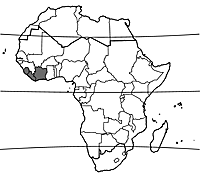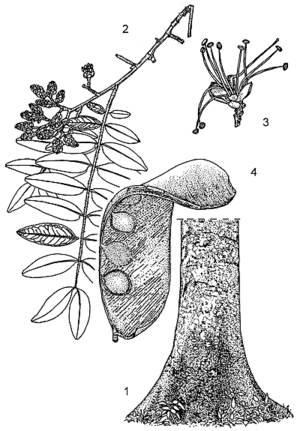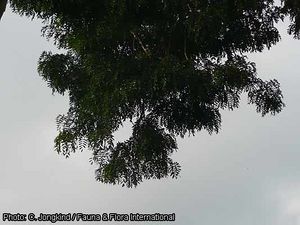Brachystegia leonensis (PROTA)
Introduction |
Brachystegia leonensis Burtt Davy & Hutch.
- Protologue: Bull. Misc. Inform. Kew 1923(4): 156 (1923).
- Family: Caesalpiniaceae (Leguminosae - Caesalpinioideae)
Vernacular names
- Bush mahogany (En).
- Méblo (Fr).
Origin and geographic distribution
Brachystegia leonensis occurs from Sierra Leone eastwards to western Côte d’Ivoire.
Uses
The wood, traded as ‘okwen’ or ‘naga’, is used for construction, flooring and furniture. It is suitable for interior joinery, interior trim, ship building, vehicle bodies, boxes, crates, carvings, veneer and plywood. It is also used as fuelwood.
A decoction of the leaves is rubbed onto the gums to treat toothache.
Production and international trade
The wood of Brachystegia leonensis is mainly used and traded locally, but may occasionally be traded internationally in mixed consignments.
Properties
The heartwood is pale yellowish brown to copper brown, with purplish tinge and darker streaks; it is fairly distinctly demarcated from the yellowish or whitish, up to 15 cm wide sapwood. The grain is interlocked or wavy, sometimes straight, texture medium. Quarter-sawn surfaces sometimes show a striped or roe figure.
The wood is medium-weight, with a density of 490–560 kg/m³ at 12% moisture content, and moderately hard. It air dries rather slowly, with a high risk of distortion, end splitting and checking. The rates of shrinkage are moderately high, from green to oven dry 4.7–4.9% radial and 7.5–7.6% tangential. Once dry, the wood is moderately stable to stable in service.
At 12% moisture content, the modulus of rupture is 116–138 N/mm², modulus of elasticity 8500–10,800 N/mm², compression parallel to grain 42–56 N/mm², shear 7.5–8 N/mm², cleavage 13.5 N/mm and Chalais-Meudon side hardness 2.2–2.8.
The wood is fairly easy to work with both hand and machine tools. It has low to moderate blunting effect on saw teeth and cutting edges. In planing and moulding, the wood has a tendency of tearing due to the interlocked grain, and a reduced cutting angle of 10–13° is recommended. Drilling and mortising properties are satisfactory. A smooth surface is difficult to obtain, and therefore ample filler is needed for a good finish. The wood is liable to splitting upon nailing and pre-boring is therefore necessary; it holds nails and screws well. Gluing and veneering properties are good. The heartwood is moderately durable, being quite resistant to termite attack but susceptible to blue stain, pinhole borer and marine borer attacks. The sapwood is liable to Lyctus. The heartwood is resistant to preservative treatment, but the sapwood is permeable.
Adulterations and substitutes
Several Brachystegia species have wood that is similar to that of Brachystegia leonensis and is also traded as ‘naga’, including Brachystegia cynometroides Harms, Brachystegia eurycoma Harms and Brachystegia nigerica Hoyle & A.P.D.Jones.
Description
- Evergreen, large tree up to 45(–50) m tall; bole branchless for up to 30 m, straight and cylindrical, up to 200(–250) cm in diameter, thickened at base or with winged buttresses up to 2 m high; bark surface smooth, becoming rough and flaking off in irregular patches, grey to dark grey-brown, inner bark thick, hard, fibrous, reddish brown to dark red with whitish, yellowish or orange streaks, with some reddish exudate; crown with ascending branches; twigs drooping, slightly hairy.
- Leaves alternate, paripinnately compound with (3–)6–12(–13) pairs of leaflets, drooping; stipules narrowly oblong, caducous but base persistent; petiole 1–3 cm long, rachis 15–28 cm long, reddish hairy; leaflets opposite, nearly sessile, elliptical to lanceolate, 1.5–12 cm × 0.5–4.5 cm, rounded but strongly asymmetrical at base, obtuse to slightly notched or short-acuminate at apex, leathery, densely brownish hairy when young, but becoming nearly glabrous, with 2–3 nearly basal veins on one side of the leaflet and 4–6 pairs of lateral veins.
- Inflorescence a dense terminal or axillary panicle up to 20 cm long, densely brown short-hairy, many-flowered.
- Flowers bisexual, nearly regular, small, fragrant, greenish yellow, sessile, at base with 2 ovate bracteoles c. 10 mm long; sepals (4–)5(–6), broadly ovate, 2–2.5 mm long, nearly glabrous; petals absent; stamens 10, nearly free, c. 1.5 cm long; ovary superior, flattened ellipsoid, c. 4 mm long, with c. 3 mm long stipe, hairy on the edges, style slender.
- Fruit an oblong, flattened pod 12–30 cm × 4–8 cm, at a right angle to the stipe, smooth but slightly wrinkled, purplish brown, dehiscent with 2 woody valves, 2–6-seeded.
- Seeds disk-shaped, c. 2 cm in diameter, smooth, brown.
- Seedling with epigeal germination; hypocotyl 5–7.5 cm long, epicotyl 6–9 cm long, brown hairy; cotyledons round, c. 1.5 cm in diameter, pressed against the epicotyl; first 2 leaves opposite, with 2–3 pairs of leaflets, subsequent leaves alternate, gradually with more pairs of leaflets.
Other botanical information
Brachystegia is a taxonomically difficult genus comprising about 30 species, distributed in mainland tropical Africa and South Africa, the majority of species occurring in southern tropical Africa, where they are characteristic of miombo woodland.
Anatomy
Wood-anatomical description (IAWA hardwood codes):
- Growth rings: 1: growth ring boundaries distinct.
- Vessels: 5: wood diffuse-porous; 13: simple perforation plates; 22: intervessel pits alternate; 23: shape of alternate pits polygonal; 25: intervessel pits small (4–7 μm); 26: intervessel pits medium (7–10 μm); 29: vestured pits; 30: vessel-ray pits with distinct borders; similar to intervessel pits in size and shape throughout the ray cell; 42: mean tangential diameter of vessel lumina 100–200 μm; 43: mean tangential diameter of vessel lumina ≥ 200 μm; 46: ≤ 5 vessels per square millimetre; 47: 5–20 vessels per square millimetre; 58: gums and other deposits in heartwood vessels.
- Tracheids and fibres: 61: fibres with simple to minutely bordered pits; 66: non-septate fibres present; 69: fibres thin- to thick-walled.
- Axial parenchyma: 80: axial parenchyma aliform; 81: axial parenchyma lozenge-aliform; 83: axial parenchyma confluent; 89: axial parenchyma in marginal or in seemingly marginal bands; 91: two cells per parenchyma strand; 92: four (3–4) cells per parenchyma strand.
- Rays: 96: rays exclusively uniseriate; 97: ray width 1–3 cells; 104: all ray cells procumbent; 115: 4–12 rays per mm; 116: ≥ 12 rays per mm.
- Storied structure: 122: rays and/or axial elements irregularly storied.
- Secretory elements and cambial variants: (131: intercellular canals of traumatic origin).
- Mineral inclusions: 136: prismatic crystals present; 142: prismatic crystals in chambered axial parenchyma cells; 143: prismatic crystals in fibres.
Growth and development
The bole diameter increment in Sierra Leone was found to be variable; at a bole diameter around 20 cm the annual increment in diameter was 5 mm, around 30 cm it was 1.5 mm and around a bole diameter of 50 cm it was 9 mm. Brachystegia leonensis is among the largest trees in its area of distribution, second in size only to Tieghemella heckelii (A.Chev.) Roberty. Trees flower from January to April, young fruits become conspicuous in June–October and seed dispersal peaks in December–February. Old leaves are usually shed between September and mid November. Flushes of reddish brown new leaves appear around the same time.
Ecology
Brachystegia leonensis is locally common in lowland humid evergreen forest, where it prefers well-drained localities. It is often associated with Lophira alata Banks ex C.F.Gaertn. and Heritiera utilis (Sprague) Sprague.
Propagation and planting
Natural regeneration is generally fair close to mother trees; seedlings and saplings are often common in gaps in the forest where there has been disturbance of the soil. There are about 700 seeds per kg. The germination rate is fair if the seeds are sown soon after collection, and germination usually starts after 7–20 days. Seedlings grow rather slowly, reaching a height of 30 cm in 1 year.
Management
In some forests in Sierra Leone, an average density of 0.8 trees with a bole diameter of more than 80 cm has been recorded per ha. Brachystegia leonensis can be managed by coppicing. Coppice shoots may grow to 4.5 m tall in 3 years.
Handling after harvest
After felling, logs should be rapidly removed from the forest because the wood is liable to blue stain and borer attacks.
Genetic resources
Brachystegia leonensis has a limited area of distribution and, although it is locally common, may be easily liable to genetic erosion with continuing deforestation in West Africa.
Prospects
Brachystegia leonensis will continue to be valued as a locally useful timber tree, but its prospects as a commercial timber for international trade seem to be meagre because its wood has moderate finishing properties and moderate durability.
Major references
- ATIBT (Association Technique Internationale des Bois Tropicaux), 1986. Tropical timber atlas: Part 1 – Africa. ATIBT, Paris, France. 208 pp.
- Bolza, E. & Keating, W.G., 1972. African timbers: the properties, uses and characteristics of 700 species. Division of Building Research, CSIRO, Melbourne, Australia. 710 pp.
- Burkill, H.M., 1995. The useful plants of West Tropical Africa. 2nd Edition. Volume 3, Families J–L. Royal Botanic Gardens, Kew, Richmond, United Kingdom. 857 pp.
- CIRAD Forestry Department, 2008. Naga. [Internet] Tropix 6.0. http://tropix.cirad.fr/ africa/ naga.pdf. November 2011.
- CTFT (Centre Technique Forestier Tropical), 1962. Information technique No 153: Comparaison des divers Brachystegia reçus au CTFT. Centre Technique Forestier Tropical, Nogent-sur-Marne, France. 5 pp.
- Kryn, J.M. & Fobes, E.W., 1959. The woods of Liberia. Report 2159. USDA Forest Service, Forest Products Laboratory, Madison, Wisconsin, United States. 147 pp.
- Sallenave, P., 1964. Propriétés physiques et mécaniques des bois tropicaux. Premier supplément. Centre Technique Forestier Tropical, Nogent-sur-Marne, France. 79 pp.
- Savill, P.S. & Fox, J.E.D., 1967. Trees of Sierra Leone. Forest Department, Freetown, Sierra Leone. 316 pp.
- Takahashi, A., 1978. Compilation of data on the mechanical properties of foreign woods (part 3) Africa. Shimane University, Matsue, Japan. 248 pp.
- Voorhoeve, A.G., 1979. Liberian high forest trees. A systematic botanical study of the 75 most important or frequent high forest trees, with reference to numerous related species. Agricultural Research Reports 652, 2nd Impression. Centre for Agricultural Publishing and Documentation, Wageningen, Netherlands. 416 pp.
Other references
- Aubréville, A., 1959. La flore forestière de la Côte d’Ivoire. Deuxième édition révisée. Tome premier. Publication No 15. Centre Technique Forestier Tropical, Nogent-sur-Marne, France. 369 pp.
- de la Mensbruge, G., 1966. La germination et les plantules des essences arborées de la forêt dense humide de la Côte d’Ivoire. Centre Technique Forestier Tropical, Nogent-sur-Marne, France. 389 pp.
- Hawthorne, W. & Jongkind, C., 2006. Woody plants of western African forests: a guide to the forest trees, shrubs and lianes from Senegal to Ghana. Kew Publishing, Royal Botanic Gardens, Kew, United Kingdom. 1023 pp.
- Kunkel, G., 1965. The trees of Liberia. Field notes on the more important trees of the Liberian forests, and a field identification key. Report No 3 of the German Forestry Mission to Liberia. Bayerischer Landwirtschaftsverlag, München, Basel, Wien. 270 pp.
- Neuwinger, H.D., 2000. African traditional medicine: a dictionary of plant use and applications. Medpharm Scientific, Stuttgart, Germany. 589 pp.
- Normand, D., 1950. Atlas des bois de la Côte d’Ivoire. Tome 1. Centre Technique Forestier Tropical, Nogent-sur-Marne, France. 148 pp.
- Normand, D. & Paquis, J., 1976. Manuel d’identification des bois commerciaux. Tome 2. Afrique guinéo-congolaise. Centre Technique Forestier Tropical, Nogent-sur-Marne, France. 335 pp.
- Poorter, L., Bongers, F., Kouamé, F.Y.N. & Hawthorne, W.D., 2004. Biodiversity of West African forests: an ecological atlas of woody plant species. CABI, Wallingford, United Kingdom. 521 pp.
Sources of illustration
- Savill, P.S. & Fox, J.E.D., 1967. Trees of Sierra Leone. Forest Department, Freetown, Sierra Leone. 316 pp.
- Voorhoeve, A.G., 1979. Liberian high forest trees. A systematic botanical study of the 75 most important or frequent high forest trees, with reference to numerous related species. Agricultural Research Reports 652, 2nd Impression. Centre for Agricultural Publishing and Documentation, Wageningen, Netherlands. 416 pp.
Author(s)
- E.A. Obeng, Forestry Research Institute of Ghana (FORIG), University P.O. Box 63, KNUST, Kumasi, Ghana
- A.A. Oteng-Amoako, Forestry Research Institute of Ghana (FORIG), University P.O. Box 63, KNUST, Kumasi, Ghana
Correct citation of this article
Obeng, E.A. & Oteng-Amoako., A.A., 2012. Brachystegia leonensis Burtt Davy & Hutch. [Internet] Record from PROTA4U. Lemmens, R.H.M.J., Louppe, D. & Oteng-Amoako, A.A. (Editors). PROTA (Plant Resources of Tropical Africa / Ressources végétales de l’Afrique tropicale), Wageningen, Netherlands. <http://www.prota4u.org/search.asp>.
Accessed 23 December 2024.
- See the Prota4U database.






